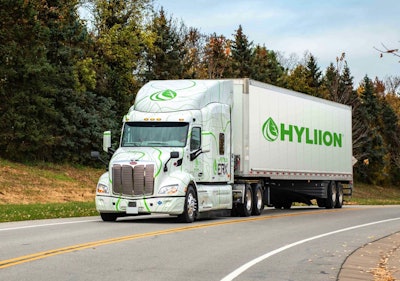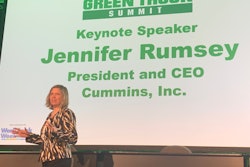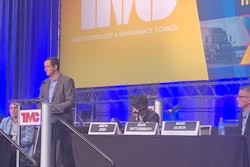
Renewable natural gas (RNG) has gained plenty of momentum as a transportation fuel and it may be poised to take off even more as proponents gear up for a lobbying session next month in Washington D.C., to further advocate for the fuel’s environmental and economic benefits over other alternative fuels like hydrogen and battery-electric.
Natural Gas Vehicles for America’s 2023 Public Policy Fly-In takes places April 18-19 at the nation’s capital where NGVA members will be meeting with members of Congress, their staffs and officials from the Departments of Energy, Transportation, Agriculture and the Environmental Protection Agency.
"We’ll be advancing our $1 per gallon RNG motor fuel tax credit bill plus [introducing] proposals for additions in the upcoming Farm Bill to promote and incentivize increased production of ag-based RNG harvesting and production for transportation use,” NGVA President Daniel Gage told CCJ.
Gage said the current alternative fuel tax credit of 50 cents per gallon applies to both conventional and renewable natural gas. Doubling that credit is expected to create more demand for RNG and natural gas trucks, busses and other vehicles.
[Related: Cummins, Hyliion partnering on hybrid nat gas truck]
 Chart from NGVA's renewable natural gas report “Start Now. RNG is How" shows how $25 million can be used to buy far more trucks that run on carbon-negative RNG than all-electric and provide better lifetime emission reductions.Natural Gas Vehicles for America
Chart from NGVA's renewable natural gas report “Start Now. RNG is How" shows how $25 million can be used to buy far more trucks that run on carbon-negative RNG than all-electric and provide better lifetime emission reductions.Natural Gas Vehicles for America
In NGVA’s online report “Start Now. RNG is How,” which Cummins also makes available on its website, the non-profit points out the environmental and economic benefits of RNG, which have long held the attention of the California Air Resources Board (CARB).
RNG, also known as biomethane, is produced from methane that’s captured from organic material in agricultural, wastewater, landfills or food waste. Since RNG production reduces methane — a greenhouse gas (GHG) that CARB and the EPA consider to be much more destructive to the ozone layer than other GHGs like carbon dioxide — it’s continued to gain more traction across political divides as an alternative fuel among those concerned with climate change.
Representatives Linda Sanchez (D-CA) and Brian Fitzpatrick (R-PA) see eye-to-eye on the value of RNG as an alternative fuel and worked together to introduce the Renewable Natural Gas Incentive Act in the House in December, which proposes the $1 per gallon RNG motor fuel tax credit.
[Related: Cummins new nat gas X15N coming to Kenworth, Peterbilt trucks]
While the bipartisan bill is encouraging, the largest RNG provider in the U.S., Clean Energy, said there’s definitely room for greater acceptance among clean air advocates.
“Well, to be honest, we wish we were seeing more of it,” said Chad Lindholm, Clean Energy’s vice president of sales. “There seems to be this electric or nothing mentality but there’s no silver bullet. There’s no single technology that doesn’t have some amount of considerations that should be taken.
“It just seems like considerations related to [EV] batteries and where the minerals are coming from and certainly the charging infrastructure are being ignored for this quote-unquote zero tailpipe, like that's everything and that means there are no emissions generated anywhere.”
RNG’s ‘massive tailwind’ despite EV headlines
Though electric is frequently promoted and heavily funded by federal and state government agencies, Puneet Jhawar, general manager of Cummins Global Spark-Ignited business, pointed out how CARB’s ongoing carbon intensity reports have continued to show RNG as having the lowest carbon intensity value among all transportation fuels, including electric and hydrogen.CARB’s latest carbon intensity value chart released in February shows a carbon intensity value of roughly -600 for RNG while electric ranks at -225 and hydrogen at -175.
“No other fuel type has a lower average carbon intensity score as RNG when looking at well-to-wheel emissions,” said Jhawar who added that RNG’s environmental and economic values are resulting in its meteoric rise in California and beyond.
 Various sources of methane including landfills can be used to produce renewable natural gas which the California Air Resources Board considers to be a carbon negative fuel. "Low Carbon Fuel Standard data shows that California fleets fueling with bio-CNG have achieved carbon negativity since 2020," said NGVA President Daniel Gage. "As an aside, 69% of natural gas motor fuel used nationally in 2022 was derived from renewable sources. In California, that figure is over 98%. So RNG is the dominant natural gas motor fuel, not conventional or fossil gas, creating an ultra-low/no/negative carbon result for fleets."NGVA
Various sources of methane including landfills can be used to produce renewable natural gas which the California Air Resources Board considers to be a carbon negative fuel. "Low Carbon Fuel Standard data shows that California fleets fueling with bio-CNG have achieved carbon negativity since 2020," said NGVA President Daniel Gage. "As an aside, 69% of natural gas motor fuel used nationally in 2022 was derived from renewable sources. In California, that figure is over 98%. So RNG is the dominant natural gas motor fuel, not conventional or fossil gas, creating an ultra-low/no/negative carbon result for fleets."NGVA
Cummins' latest natural gas engine, the X15N, is expected to help sway more fleets to RNG and its fossil fuel equivalent.
“We expect the Cummins X15N will improve on the performance, power and torque ratings our current natural gas products, but deliver a compelling total cost of ownership,” Jhawar said. “We know TCO drives a lot of decision making in the industry. Fleets wants to maximize their resources and investments, so it needs to make economic sense first before they’ll consider a new technology or fuel type.”
Increased pressure to cut emissions to improve Environmental Social Governance (ESG) scores and increased funding may motivate even more fleets to sign up for RNG.
According to Gage, $2.5 billion in discretionary funding for fueling infrastructure from the Federal Highway Administration can be used to expand propane, hydrogen, charging and natural gas infrastructure.
The convergence of additional funding for RNG along with a negative carbon value, proven powertrain capability and available fueling infrastructure is helping to drive more interest in Hyliion’s Hypertruck ERX, a hybrid Class 8 truck powered by Cummins that’s gearing up for long haul.
“RNG has a massive tailwind right now. It's fantastic for us,” Hyliion CEO and founder Thomas Healy said. “It’s expected to significantly increase over the years ahead as well. Fleets see it as a low-cost fuel that has great emissions profiles that can help them meet their net carbon zero goals.”
Hyliion is also pursuing hydrogen fuel cell technology through a partnership with Hyzon but recognizes that the fueling infrastructure to support fuel cell trucks is limited to roughly 50 stations in California.
“Let’s say I want to deploy hydrogen vehicles here in Texas. You have to build a station and figure out green production of hydrogen, plus you have to get the vehicles. It will take years to do this versus with our solution, the natural gas range extender,” Healy said. “We’re going to set you up with the fuel provider who can lock you in around a dollar a gallon. This is really easy and much more feasible than some of the other options out there.”
Major fleets like UPS and Amazon have been eager to adopt RNG for its ability to quickly improve their emissions profile.
“Amazon has launched CNG tractors, which are fueled by renewable natural gas sourced from landfills and dairy farms,” said Amazon spokesperson Kate Scarpa. “As of 2021, we had ordered more than 3,000 CNG vehicles, and we are procuring millions of gallons of renewable natural gas created from waste stocks to power them, significantly reducing carbon emissions and particulate matter pollutants.”












